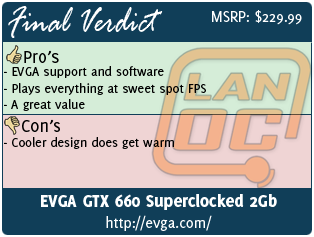 It wasn’t that long ago that we had the chance to take a look at the GTX 660 Ti and check out its amazing performance at the $300 price point. Along with the copy of Borderlands 2 that was bundled with it at launch I was impressed with its price. Of course there are still people who can’t afford that price point. Because of this, Nvidia continues to fill in its Kepler lineup, today introducing both their GTX 660 and GTX 650. We will take a look at what the launch is all about and then put our EVGA GTX 660 Superclocked 2Gb to the test at both stock and overclocked speeds to show you the performance difference when you pick up an overclocked model like the one provided by EVGA today.
It wasn’t that long ago that we had the chance to take a look at the GTX 660 Ti and check out its amazing performance at the $300 price point. Along with the copy of Borderlands 2 that was bundled with it at launch I was impressed with its price. Of course there are still people who can’t afford that price point. Because of this, Nvidia continues to fill in its Kepler lineup, today introducing both their GTX 660 and GTX 650. We will take a look at what the launch is all about and then put our EVGA GTX 660 Superclocked 2Gb to the test at both stock and overclocked speeds to show you the performance difference when you pick up an overclocked model like the one provided by EVGA today.
Product Name: EVGA GTX 660 Superclocked 2Gb
Review Sample Provided by: EVGA
Written by: Wes
Pictures by: Wes
Specifications
|
Base Clock |
1046 MHz |
|
Boost Clock |
1111 MHz |
|
Memory Clock |
6008 MHz Effective |
|
CUDA Cores |
960 |
|
Bus Type |
PCI-E 3.0 |
|
Memory Detail |
2048MB GDDR5 |
|
Memory Bit Width |
192 Bit |
|
Memory Speed |
0.33ns |
|
Memory Bandwidth |
144.19 GB/s |
|
Texture Fill Rate |
83.68 GT/s |
|
Dimensions |
Height: 4.376in |
|
Accessories |
EVGA Driver/Software Disc |
GTX 660 and GTX 650
When Nvidia went over all of the details on the GTX 660 and 650 launch with us they started us off with a quote from Cevat Yerli, CEO of Crytek. He was recently quoted saying “This time we promise to melt down PCs” when referring to Crysis 3. Crysis 2 was focused on consoles with PC gaming more of an afterthought. This time around they mean business, focusing on PC gaming first and frankly I think everyone is happy to hear that. Because of the prevalence of console ports a lot of gamers haven’t really needed to upgrade to Direct X 11, meaning its integration has been slow at best as what can be seen in the graph below. Of course, with DX11 cards having been around for going on four years now, those who have held out for four or more years are in need of an upgrade. Those who wait four years to upgrade are looking for a great value to get them a jump in performance without breaking the bank. That is where Nvidia thinks the GTX 660 will fit in. With a MSRP of $229 it won’t break the bank, but they promise performance that will give you your money’s worth.
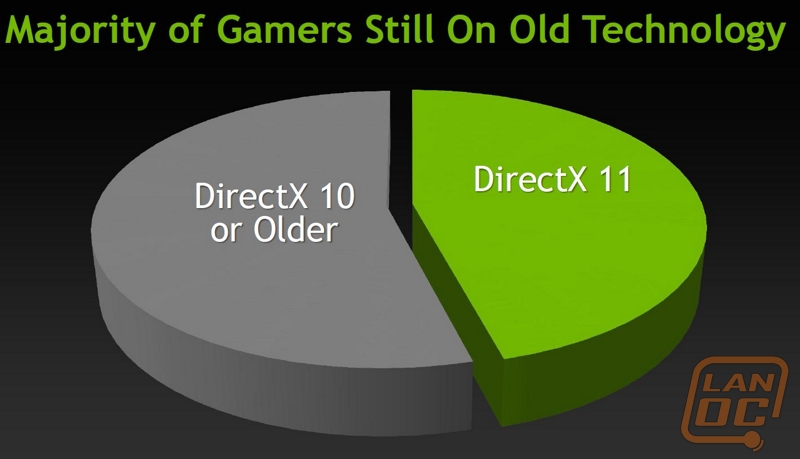
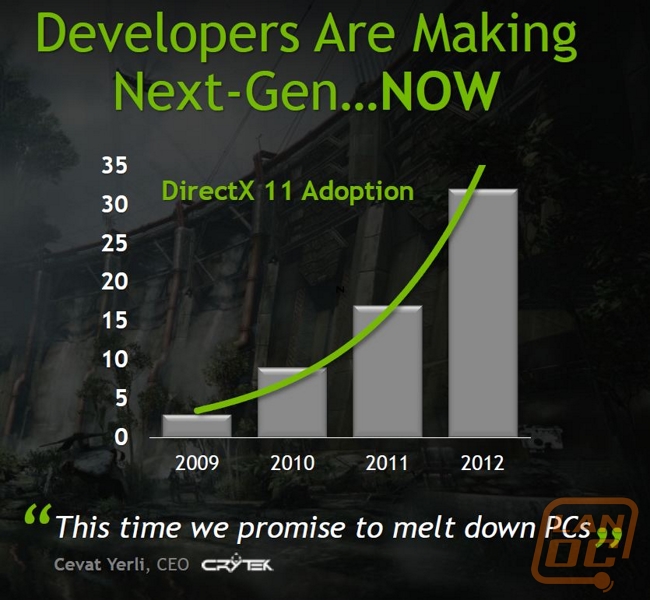
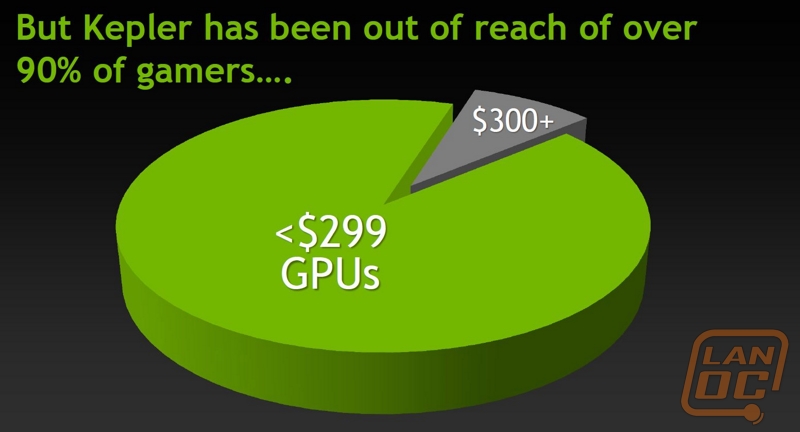
Here is how the cards break down and for comparison purposes I have included the corresponding specification listing for the GTX 660Ti to show where the GTX 660 and GTX 650 fit in.
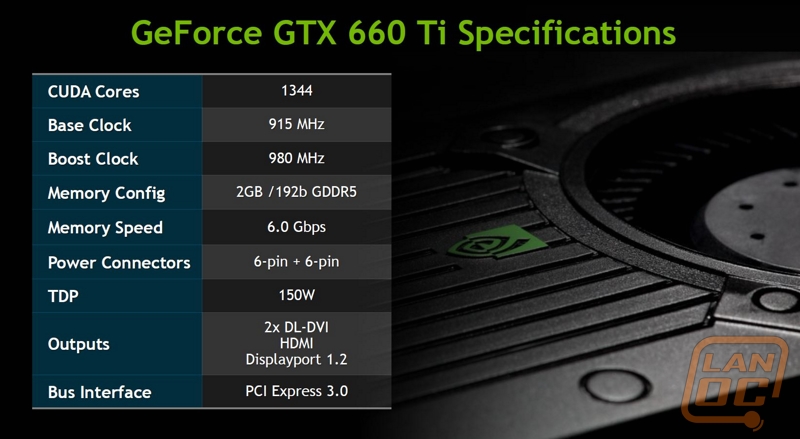
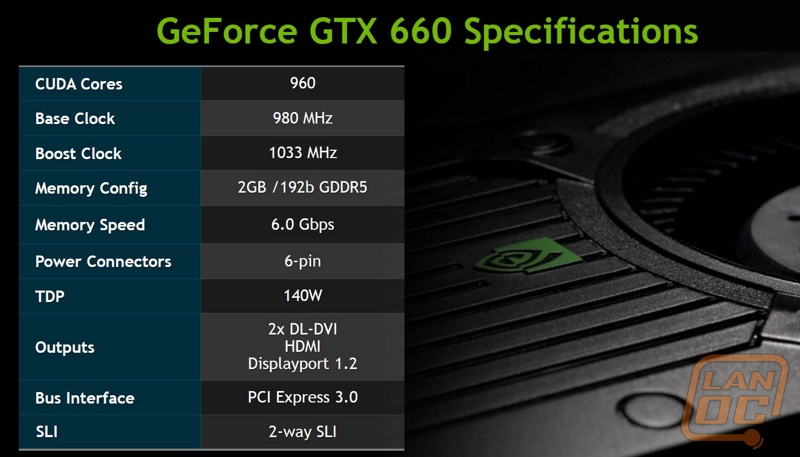
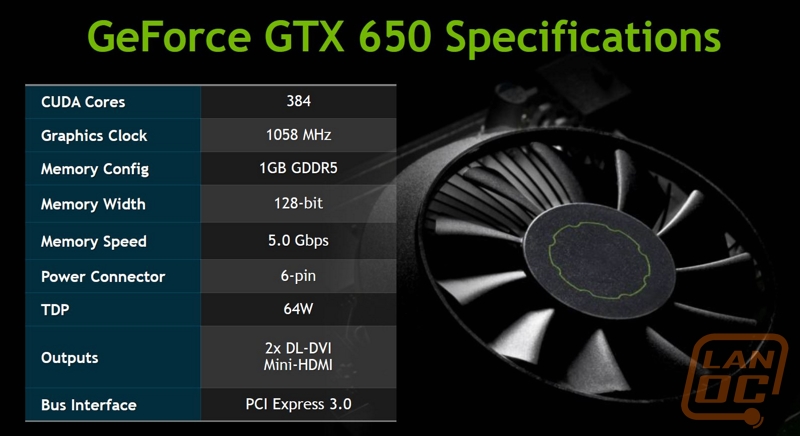
As you can see the GTX 660 and the GTX 660 Ti are similar in base clock, memory, and memory speed. But where there is a different is in the number of CUDA cores powering everything as well as the TDP. With a relatively small 10 watt drop it was enough to only require one six pin power connection on the GTX 660 where the GTX 660 Ti needed two. The GTX 660 Ti also came with two SLI bridge connections meaning up to quad SLI due to its roots in the GTX 670, the GTX 660 only has the one.
Jumping to the GTX 650 you can see the CUDA cores drop almost two thirds down to 384. The Graphics clock is up there at 1058, but without GPU boost on this model they are able to raise that up slightly. The stock configuration will come with 1GB of GDDR5 but they are also expecting to see 2GB models out as well. Memory speed is a little slower than the GTX 660 as well with the GTX 650 coming in at 5.0 Gbps and the GTX 660 at 6.0 Gbps. TDP is an extremely low 64 watts, but it does still require one six pin connection for power. Here are both of the block diagrams; you can see the differences right away.

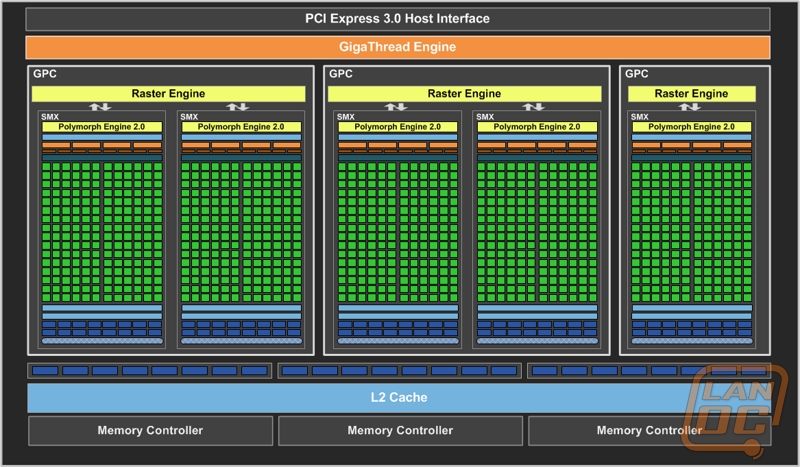
Packaging
At first glance the packaging for the GTX 660 is much like the GTX 660 Ti that we recently took a look at. Oddly enough, even though they are basically the same size, the packaging this time around is noticeably smaller. We still have all of the same information at our finger tops though. Right on the front of the box you can see the model, the Superclocked label, all of the information about the cards memory capacity and support for PCI Express 3.0, Physx, 3D Vision, ect. They also slipped in a nice logo up in the top right corner showing that this card supports two way SLI, this way you don’t accidentally go home with too many cards. Of course on top of all of that, the EVGA logo is very in your face, covering most of the cover. Considering their reputation, I don’t blame them for wanting to put that out there.

Around back there are more in depth listings of the cards key features and what is included in the box. Each listing is relisted again in four other languages as well. Here you get a peek at the card itself as well as a nice photo of all of the GTX 660’s connections. We will look at those more later though.

Inside the more compact box you have to fight with things slightly to get everything out. Once you get it all out you will find you normal 6 pin adapter, DVI to VGA adapter as well as documentation, your driver and software disc, and one of EVGA’s nice case badges. Along with them the card itself comes wrapped up in a bubble wrap static protective bag. Inside the card itself has a thin plastic film to protect it from fingerprints and scratches before it gets to you.



Card Layout and Pictures
From this angle, without looking at the model name on the card, you wouldn’t spot the difference between this and the GTX 660 Ti that we last covered. This isn’t a bad thing at all, I loved the style. The two tone look is just enough to make the card stand out without being in your face at all. As for the cooler design, it is basically a reference cooler design with a slightly different fan shroud to accommodate the EVGA styling. This works out well for us, we will be doing testing with this card at both stock speeds and the Superclocked speeds due to not having a reference card on hand for that testing.


I love that the name of the card is right there and easy to find above the fan. As you can see from there this is a typical reference style fan design as well.

The EVGA logo on the PCB here will never be seen once the card is installed, but it’s still a nice touch.

Up top, once again we have the GTX 660 logo right in an area that you will be able to see through a side window on a case. Along with that you have the single SLI connection and one single six pin power connection mid-way up the card. Its small, but I love that EVGA includes a protective piece for the SLI bridge connection for those who won’t end up using it.



Being a reference style design, the entire card is sealed off, that means all of the air is forced to head out the back and not back into your case. For cases that struggle with heat already, this is important.

No matter how many times that I see the short PCB on the Kepler cards, I still have a hard time getting used to it. They really pack everything into a small PCB, so small in fact that they had to go longer on the cooling to keep everything cool. This design also allows for a slightly larger fan design to help push the air out as well.

For back panel connections you get two DVI connections, one DVI-d and one DVI-I. You also have one full sized HDMI port and one full sized Displayport 1.2 connection at your disposal if needed. Just like the GTX 660 Ti, the PCI plate on this card is opened up for the highest air flow in every possible way. I love that they include this and don’t make it and upgrade like they used to in the past.

Our Test Rig
Asus Rampage IV X79 Motherboard
Seagate Constellation 2tb Hard drive
Cooler Master Gold Series 1200 Watt PSU
http://www.highspeedpc.com/ Test Bench
Kingston 1600Mhz DDR3 Quad Channel Ram
Kingston Hyper X 120 SSD
Our Testing Procedures
Batman Arkham Asylum (built-in benchmark; 1920 x 1080; Multi Sample AA 16XQ; Detail Level: Very High; Bloom: Yes; Dynamic Shadows: Yes; Motion Blur: Yes; Distortion: Yes; Fog Volumes: Yes; Spherical Harmonic Lighting: Yes; Ambient Occlusion: Yes; PhysX: Off)
F1 2011 (built-in benchmark; 1920 x 1080; Multi Sample AA 4x; Vsync: Off; DirectX: 11; Shadows: Ultra; Particles: High; Crowd: High; Drivers: Ultra; Distant Vehicles: Ultra; Objects: Ultra; Trees: Ultra; Vehicle Reflections: Ultra; Post Process: Ultra; Skidmarks: On; Cloth: High)
Super Street Fighter Arcade Edition (built-in benchmark; 1920 x 1080; Multi Sample AA: C16xQ; Vsync: Off;Filtering: 16x; Model Quality: High; Stage Quality: High; Soft Shadow: Extreme; Self Shadow: High; Motion Blur: High; Particles: High; Extra Effect: Off)
Dirt 3 (192x1080 - 4xMSAA - high settings, in-game benchmark)
Metro 2033 DX11 (built-in benchmark, 1920 x 1080; DirectX: DirectX 11; Quality: Very High; Antialiasing: MSAA 4X; Texture filtering: AF 4X; Advanced PhysX: Enabled; Tessellation: Enabled; DOF: Disabled)
Metro 2033 DX10 (built-in benchmark, 1920 x 1080; DirectX: DirectX 10; Quality: Very High; Antialiasing: MSAA 4X; Texture filtering: AF 4X; Advanced PhysX: Enabled; Tessellation: Enabled; DOF: Disabled)
Total War: Shogun 2 Direct X11 Benchmark High setting
Crysis 2 Using Adrenaline Crysis 2 benchmark two runs. The first set of runs set to ultra-settings, 1080p, 4x Anti-Aliasing, DX11, Laplace Edge Detection Edge AA, on the Times Square map, with hi res textures turned on. The second benchmark set to Xtreme at 1080p, no AA, DX9, Edge Blur, Hi-Res Textures turned off on the Times Square Map.
Battlefield 3 Using Fraps with the game set to Ultra settings with 4x MSAA Antialiasing Deferred, 16X Anisotropic Filter, at 1920x1080.
Sniper V2 Elite 1920 x 1080 resolution, graphics detail set to ultra
Dirt Showdown 1920 x 1080 resolution, 4x MSAA multisampling, vsync off, Shadows: ultra; Post Process: High; Night Lighting: High; Vehicle Reflections: Ultra; Ambient Occlusion: Ultra; Water: high; Objects: Ultra; Trees: Ultra; Crowd: Ultra; Ground Cover: High.
Synthetic Benchmarks For video cards our synthetic benchmarks are limited to 3DMark Vantage and 3DMark Vantage 2011. 3DMark Vantage is run with PPU turned off with results from both the performance and high settings. In 3DMark Vantage 2011 we run both performance and extreme benchmarks
Unreal Heaven Benchmark DX11 (API: DirectX11; Tessellation: Disabled; Shaders: High; Anisotropy: Off; Stereo 3D: Disabled; Multi Monitor: Unchecked; Anti-aliasing: 8x; Full Screen: Checked; Resolution: 1920 x 1080)
FurMark We use Furmark to push the video card to the limit and test its cooling performance. Keep in mind that FurMark pushes cards well beyond what they would ever do in game. Our tests are done using the built in 1080p benchmark. All testing is done with a room temperature of 70 degrees.
Cooling and Noise
Most of you should know about our testing process for cooling and noise. For those that don’t know how it works. We use Furmark to put every card under more load than any game could. While doing that, we keep the fan settings set to automatic. This way we can see how hot the card will get under this extreme load without having to tweak the fan speed. Along with that we judge the noise performance while doing this. Of course if we cranked the fan speed up to 100% we would hear more noise, but we want to know what you should expect under normal use.
This time around we did testing with the card set to its factory overclocked speed as well as running it again later with the settings turn down to a factory speed. With this being basically a reference design we can also get a good idea of how a reference GTX 660 would perform in this test. As you can see, both of our results are a little on the high side, but about where we expected when compared to the GTX 680 and GTX 670. The stock speeds put the card just below the GTX 660 Ti but the Superclocked speeds did get us a little hot at a whopping 78 degrees Celsius.
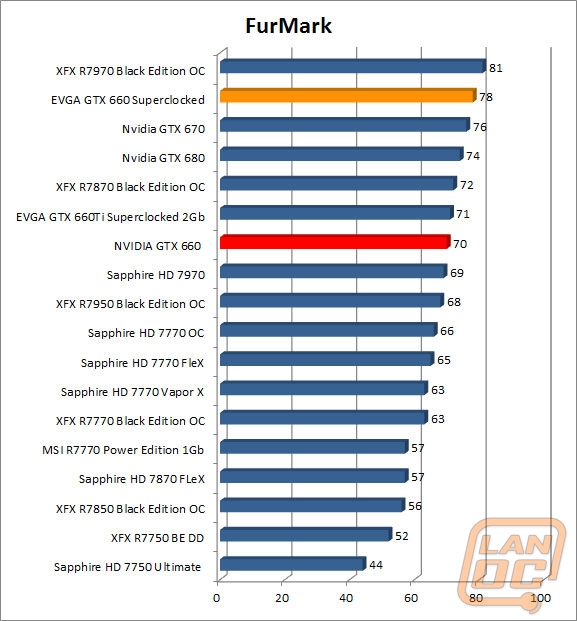
As for noise levels, the stock version was slightly quieter under load as the fan did spool up a little on both. When not under load both variations were dead silent as well. Overall the sealed design is great for preventing air from getting pushed into your case, but the card does suffer a little bit because of it.
3DMark
Surprisingly, our benchmark numbers put the GTX 660 almost spot on with the performance we saw from the GTX 580 Classified at stock speeds. This is especially impressive when considering the price difference between the cards then and now. As for where it stands against AMD’s offerings it varies slightly showing performance close to and above the HD 7870. What kind of improvement will the Superclocked offering from EVGA get you over a stock clocked model? Well the difference is noticeable in every one of our tests, but it is more noticeable on the less demanding performance settings. 3DMark Vantage Performance for example will jump you from 17682 to 18365.
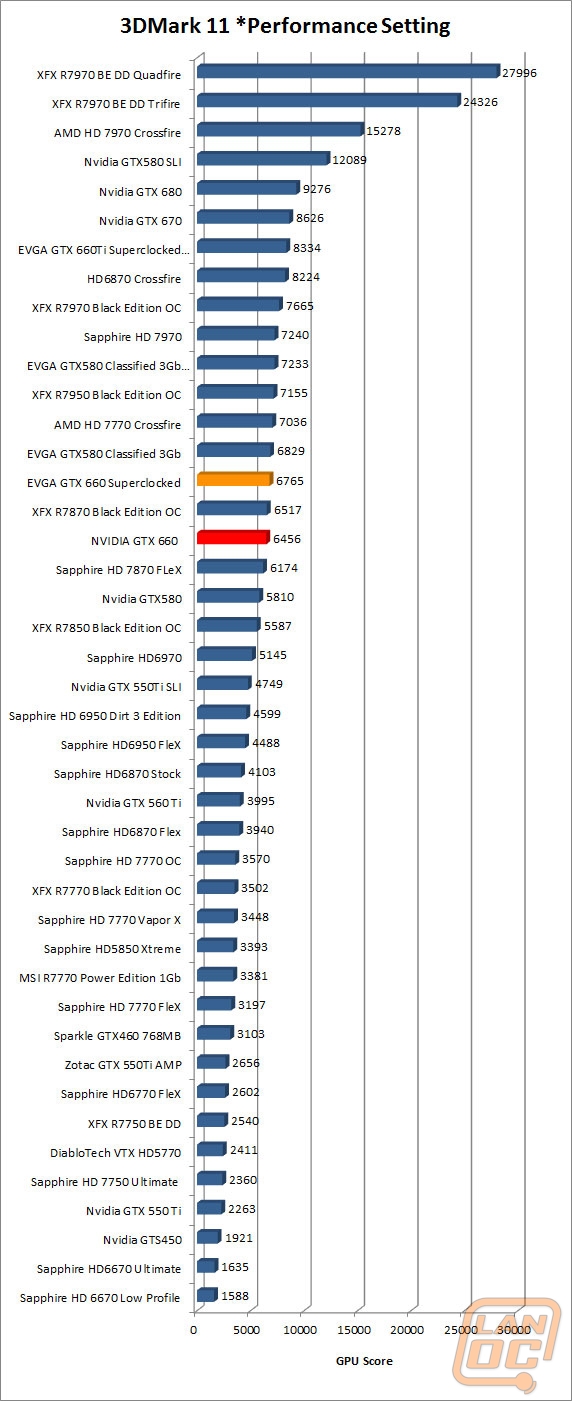
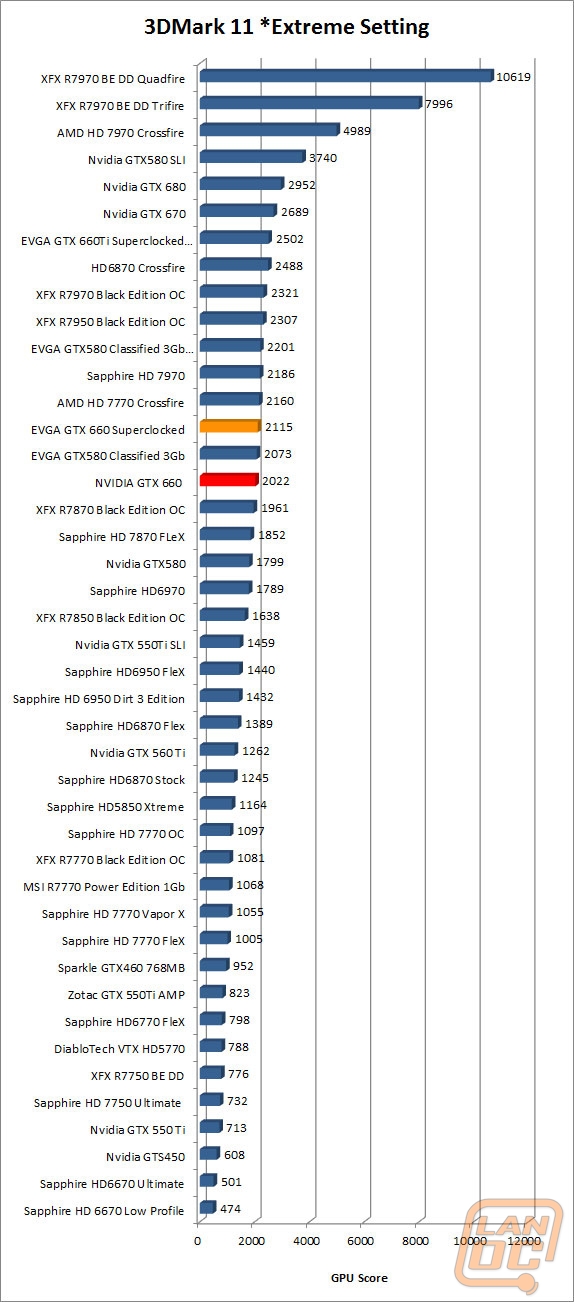
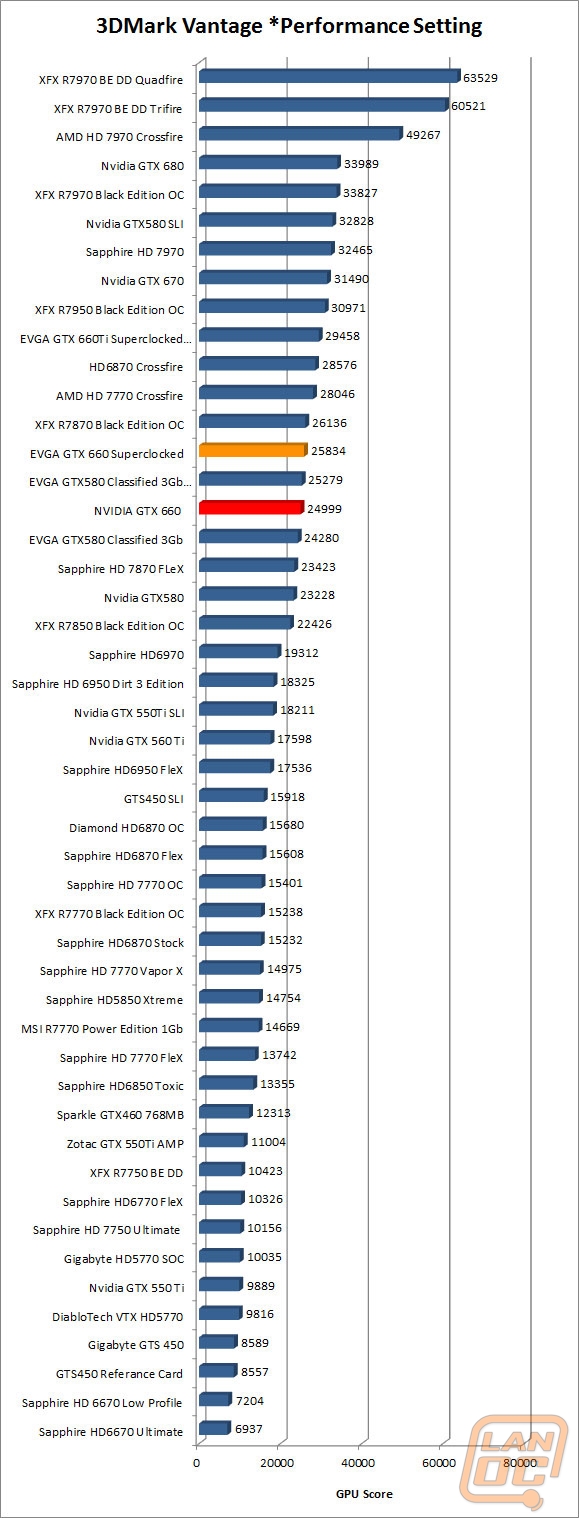
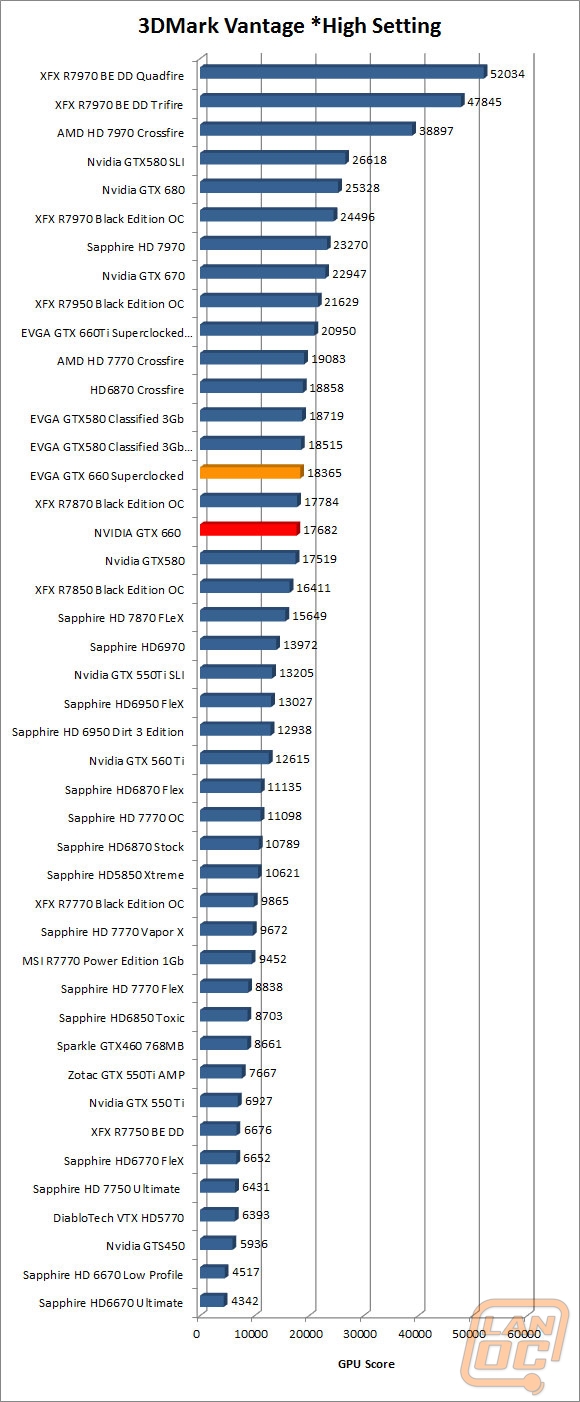
In Game Performance
In almost every single case the GTX 660 both stock and Superclocked came in right with the HD 7870. Typically the every overclock was just enough to push it up over the top. In Battlefield 3 for example, that gave us an average of 55 and 57 FPS with the settings turned up. That means that even in one of today’s most demanding games the GTX 660 gets you near the sweet spot in FPS. We saw the same thing in both of our Crysis 2 benchmarks as well, they are just as demanding. In the AMD favoring Shogun 2 we did see the HD 7870 up a few more FPS over the GTX 660 results, but they still came in up near that sweet spot as well.
The difference between the stock and Superclocked versions once again is noticeable with at least a few FPS in almost every benchmark. Some like Dirt 3 show just over 8 FPS even.
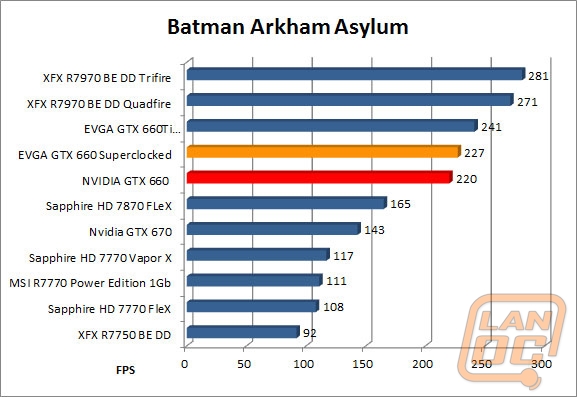
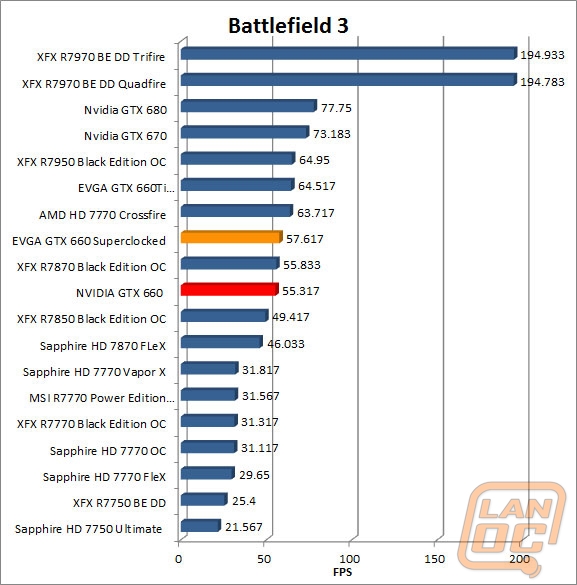
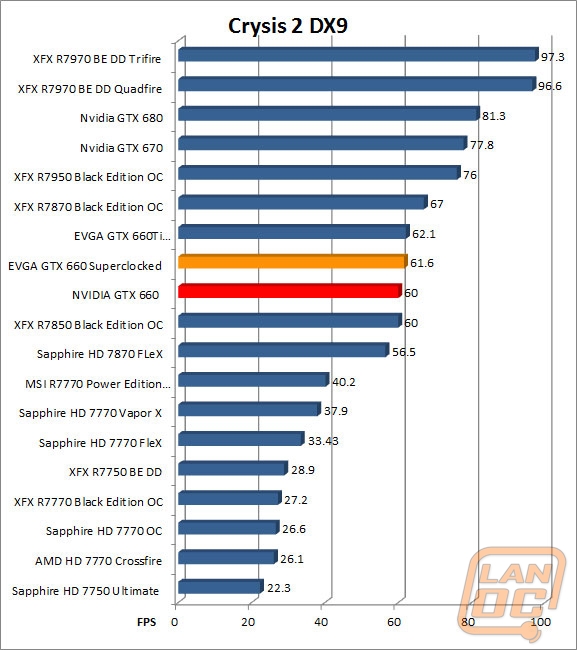
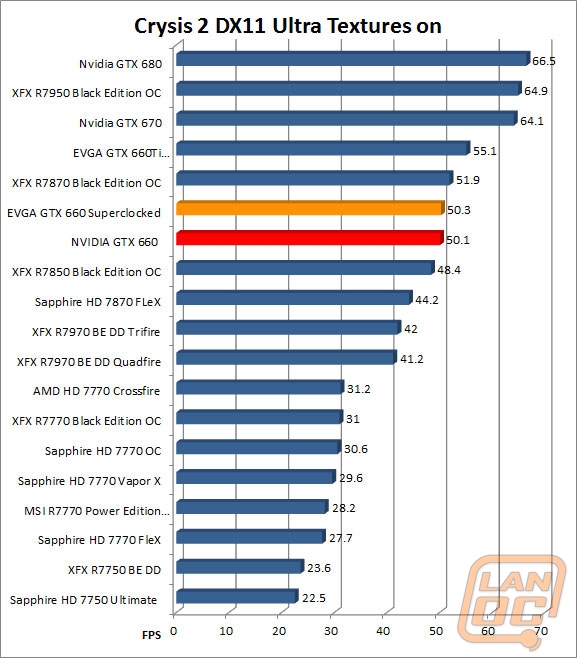
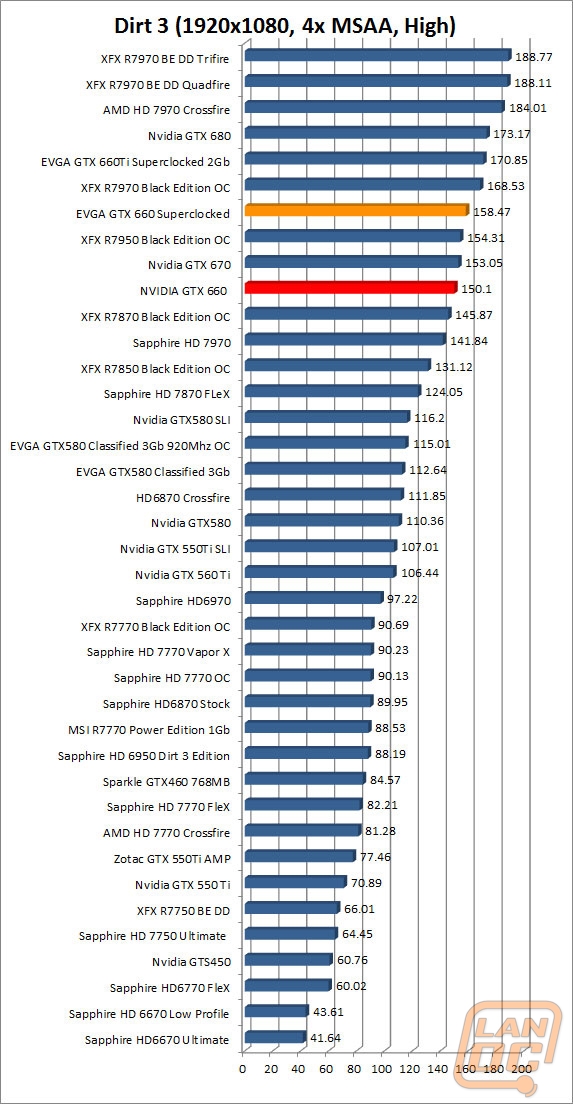
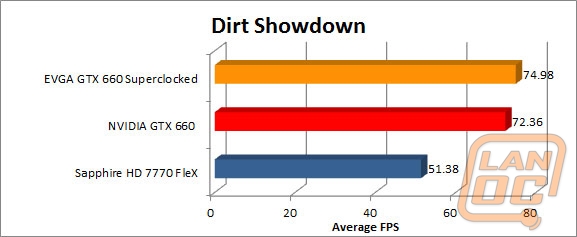
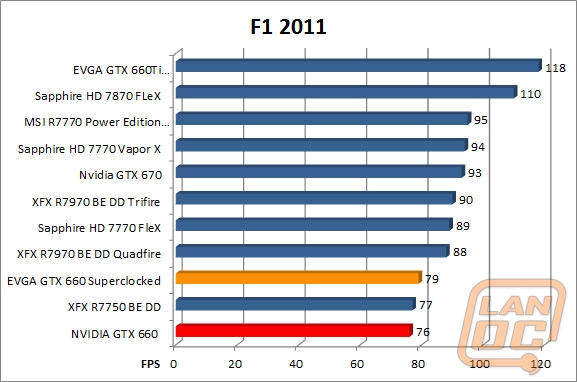
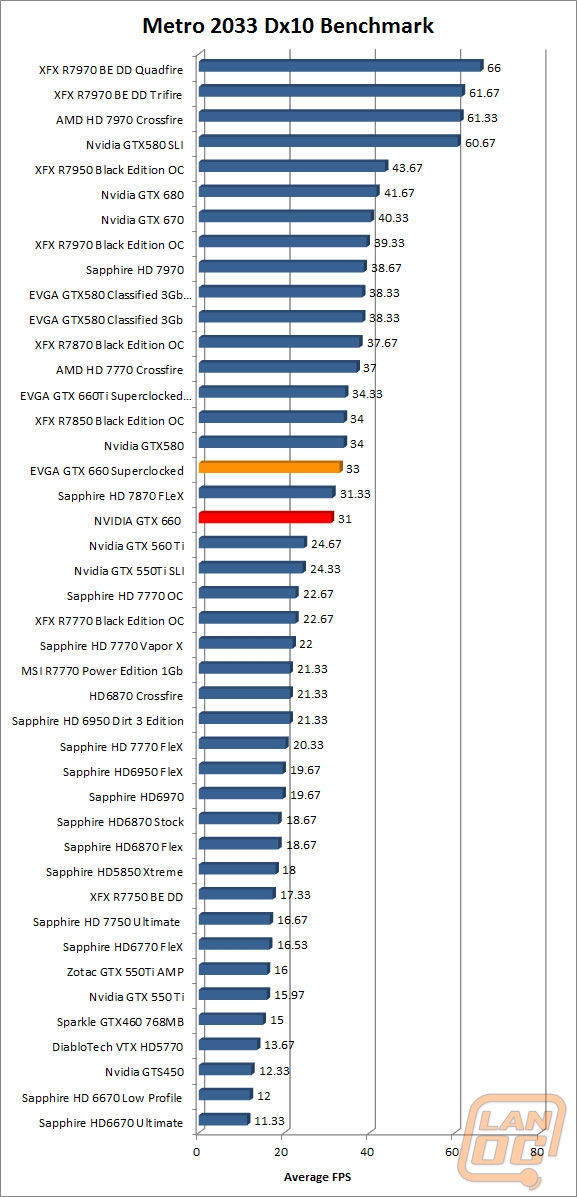
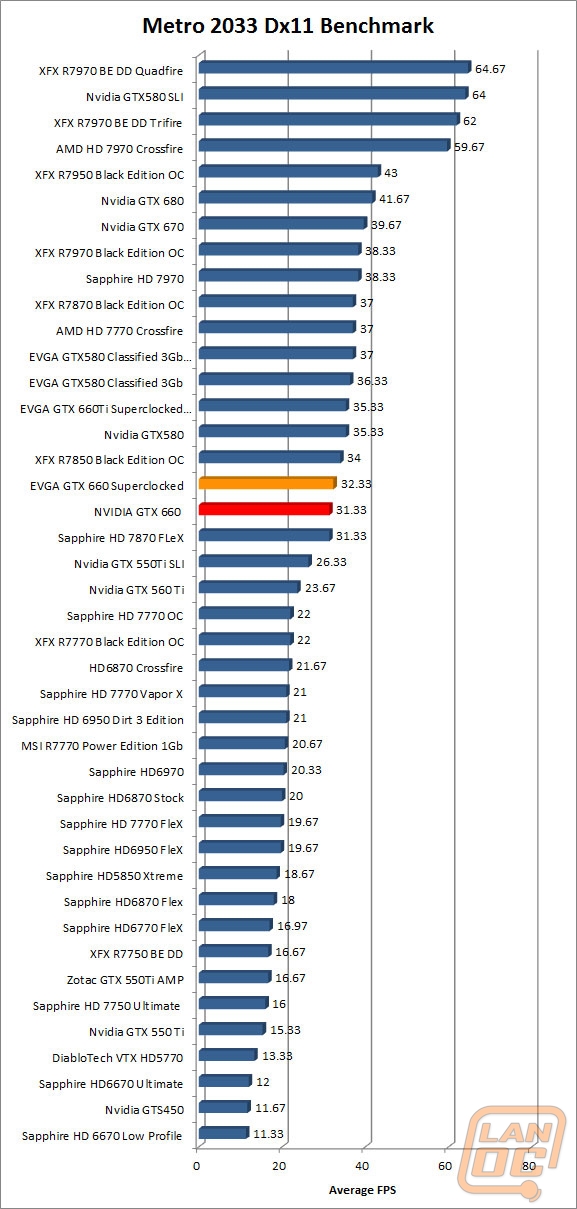
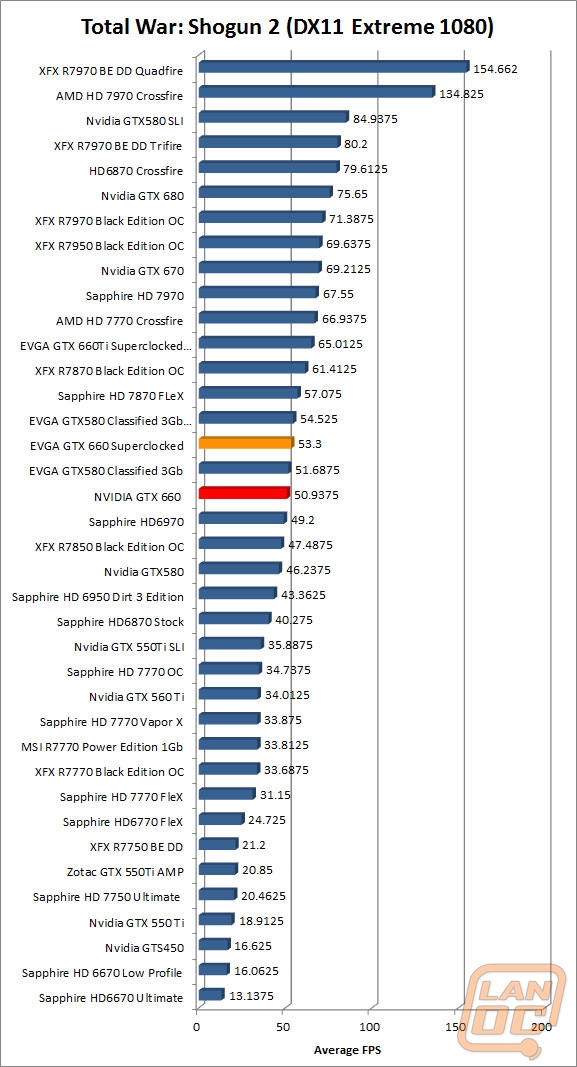
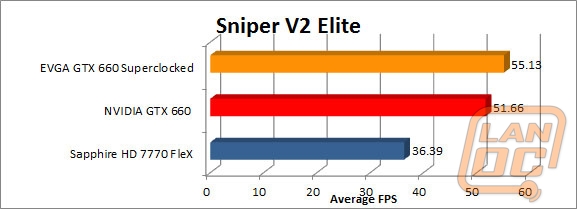

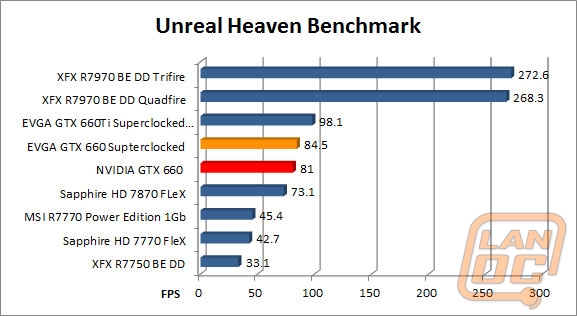
Overall and FV
Once again, much like the GTX 660 Ti, I came away from testing the GTX 660 impressed. At a $70 price drop when compared to the GTX 660 Ti there just isn’t that big of a difference in performance. That means that Nvidia is introducing a card to the market that performs amazing at a price point that even more people will be able to afford. Of course if money wasn’t an option I would go with the GTX 660 Ti or higher for more CUDA cores. But when benchmarking and gaming at a resolution of 1080p, you are going to have a hard time finding games this card won’t play at nearly 60 FPS. As far as the competition from AMD, we haven’t officially gotten a GHz 7870 to put to the test. Our original performance numbers from the overclocked XFX 7870 should be close though and it does slightly outperform the GTX 660. Of course they are listed starting at $260 with a rebate to get you down to $240. The GTX 660 is slightly cheaper and you don’t have to jump through rebate hoops.
As long as Nvidia and AMD continue to push prices down and increase performance of their cards to compete with each other, the customers like you guys can’t really loose.
What about the card that EVGA provided us with. This time around we tested both stock and overclocked speeds to give you guys a better idea of what the Superclocked performance was getting you. Honestly, I was impressed that we saw the difference that we did. It might seem slight in some cases, but the Superclocked version is like a midway between the GTX 660 Ti and the GTX 660. Even better is the card itself will be sold at the same $229.99 price point that Nvidia has priced stock speed cards at.
Going with the EVGA card does get you a few benefit’s though. On top of the slick two-tone styling that I love, you also get typical EVGA support. That means you have a 3 year warranty that can be upgraded to 5 and 10 years if needed. The warranty is transferable and you don’t even need to have an account to RMA. You also have everything else that EVGA is known for with the step up program and US based customer support.
The GTX 660 also comes with EVGA’s Precision X software that can be used to inch even more performance out of your card as well as control and monitor your temperatures and fan speeds. They have even made a specific skin designed for the GTX 660 to show off what card you have in your software.
